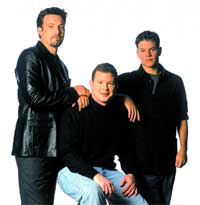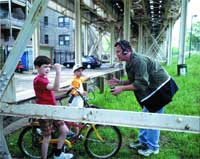 Pete Jones was just another fledgling screenwriter desperately trying to sell his first script. Then, along with 10,000 other aspirants, he entered his screenplay in Project Greenlight, a contest in which the winner was given the opportunity to direct his first feature, with a $1 million production budget and theatrical distribution provided by Miramax Films. Avid Technology supplied a fully configured Avid Xpress DVD Dell desktop system with V. 1.5 software to each of the 10 finalists. They were allowed to keep the system for 12 months.
Pete Jones was just another fledgling screenwriter desperately trying to sell his first script. Then, along with 10,000 other aspirants, he entered his screenplay in Project Greenlight, a contest in which the winner was given the opportunity to direct his first feature, with a $1 million production budget and theatrical distribution provided by Miramax Films. Avid Technology supplied a fully configured Avid Xpress DVD Dell desktop system with V. 1.5 software to each of the 10 finalists. They were allowed to keep the system for 12 months.
Quicker than you could say "Cut! Print!" Jones' screenplay Stolen Summer, about a young Irish Catholic boy trying to get his dying Jewish friend into heaven, won the competition. And the 31-year-old Illinois native became the centerpiece of an integrated multimedia phenomenon. The fact is, Project Greenlight was more than just a feeding frenzy for screenwriting wannabes. It also encompassed a Web site originally set up as a forum for writers and filmmakers to communicate with each other; an HBO documentary series about the making of Stolen Summer; and the finished film itself, which debuted at this year's Sundance Film Festival.
The site (www.projectgreenlight.com), where the contest was announced and people submitted their entries, kicked off the whole phenomenon. But it evolved over time into a community of sorts, attracting as many as 100,000 daily hits, in which Hollywood creative types can network and discuss their problems. It has also become an adjunct to the HBO series, featuring additional information and footage (such as pre-production memos) not seen on the show.
Chris Moore, executive producer of the film and documentary series, whose company LivePlanet designed and maintains the site, says its "content is an ongoing process. We were conscious of being integrated, and that there had to be a reason for everything to happen, not just do a fan site, or one of those movie PR sites. We wanted to make sure we had original content and that the site was its own place, where people learned different things, but where they also went to get different kinds of materials. We have two principles: interact with the show, and learn more about Hollywood. Avid has been helpful, because we can edit for the show and the Web site at the same time."
THE MOVIE
The film itself was shot over 25 days in Chicago, using 35mm stock. Because none of Stolen Summer involved effects work, about only 30 percent of its $1.3 million budget went into post production, including 18 weeks of editing. Director Jones, whose only previous work in the industry was as a production assistant on some reshoots for the Mike Nichols film Primary Colors, admits he's "not terribly" up on technical matters (he doesn't even know what cameras he used). So Jones spent most of his energy working with the actors, while relying on his crew and director of photography Pete Biagi to light and shoot the scenes.
But Jones, who has worked with Apple Final Cut Pro, was heavily involved in the editing process, which was done on Avid gear - including a Meridian-based Avid Film Composer v.10, an Avid Media Composer v.10 and an Avid Xpress v.4 - at LivePlanet's Santa Monica offices. "I would not consider myself close to an expert on an Avid," he says. "It was very user friendly; you could just call up scenes and they would pop up. I loved the editing process, and I learned that some of editing is disguising the mistakes you made in production. I like the freedom that if, say, scene 55 is not working where I placed it in the script, I can move it somewhere else. It allows you the freedom to tell the story."
 Jones mentions, for example, one scene in which star Aidan Quinn is supposed to look at co-star Kevin Pollak, then look down. But when Jones went to edit the sequence, he realized he wanted it to end with Quinn looking directly at Pollak, "so in the Avid we just reversed the eyes, reversed the shot, and it ends with a close-up of Aidan's eyes."
Jones mentions, for example, one scene in which star Aidan Quinn is supposed to look at co-star Kevin Pollak, then look down. But when Jones went to edit the sequence, he realized he wanted it to end with Quinn looking directly at Pollak, "so in the Avid we just reversed the eyes, reversed the shot, and it ends with a close-up of Aidan's eyes."
The show about the whole filmmaking process, which aired on HBO for six weeks, covers everything from the Project Greenlight awards ceremony to Stolen Summer's reception at Sundance. "What I wanted to get was the drama" of the process," says Moore. "The biggest issue was that there was a lot of extra footage. We debated whether the show's job was to teach people how to make a movie, or was it just meant to be interesting TV."
THE DOCUMENTARY
Series producer Liz Bronstein decided to use Betacam on the documentary shoot. Digi Beta was rejected because it was too expensive, and DV was also shot down because, says Bronstein, "I didn't think it looked as good and didn't have the capabilities to deal with complicated audio. We had a lot of wireless mics." Besides, she adds, Betacam "looks terrific and all the shooters I wanted to hire shoot Beta."
Bronstein used up to four crews daily, at times using as many as nine wireless mics. Over 1,300 hours of film was shot, the amount often determined by specific circumstances: the first two shows, for example, which involved the pre-production process, covered two months and 300 hours of footage; Episode five, Pete Jones's first day of shooting, employed three crews, which produced 15 hours of video.
As far as what could or could not be shot, everything was fair play. Stars like Matt Damon and Ben Affleck (executive producers of the film and series), Aidan Quinn and Kevin Pollak, as well as various Miramax executives, all agreed to appear on-camera, warts and all. "There were no ground rules for the shoot," says Chris Moore. "It wasn't difficult, because we said we're not doing this unless you agree to do it."
Adds Bronstein: "The hardest problem we had was with the crew [on location] in Chicago. They're used to being behind the camera and didn't want their careers ruined. The actors were also nervous; they aren't used to being filmed in their process. Certain actors didn't want us to film their rehearsals, so we had to be sensitive to their creative process."
Given all this material to work with, it's no surprise that the post production process often had the logistical complexity of a major military maneuver. First the producers had to decide how to structure the series because, says Bronstein, "each episode has to be about something. Filmmaking is really complicated, everything is so intertwined. So we had to make sense out of the chaos of that - what are the stakes, what the jeopardy, for Pete and for Miramax."
Once these parameters were set, the process was handed over to post production supervisor Jared Bushansky and his small army of helpers: four editors, five assistant editors, a tape vault librarian, post production coordinator, several production assistants and about 10 loggers contributed to the series. This staff worked with 3,000 source tapes, each containing about 30 minutes of material. The loggers logged the footage, transcribed any interviews shot as part of the show and then entered them into a database. The editors, who used the Avid Media Composers running with a Unity System as their basic tool for the offline, then digitized this material.
The Avid is "great," says Bushansky, "because our assistant editors can digitize the material into the Unity system, and then every editor can grab the material for their own bay. They can share common elements, or we can have an editor finish a cut in one room, then play it in all the bays. We can keep editing while watching the shows in another room. Every bay can use the same or different material. If this much material were on film, I don't think there would be a storage facility big enough to store all of it."
Using the Avid Symphony, which was based at rental house Three Point Digital in West LA, says Bushansky, "you digitize the material uncompressed, color correct in the Symphony, then output a final product. It streamlines the process." Finally, the show's composer recorded to a DA-88 from TASCAM, then transferred the music to a DVD, which is what Bushansky and his team worked from. Audio mixing was done at Wildwoods in LA.
Each episode took about six weeks to put together. The editors were given four weeks for their cut, then Bronstein did two weeks of notes, after which LivePlanet and Miramax gave about a day of feedback. Final post, including sound and music mix, took about another week.
So far, so good. The series opened to excellent reviews and plenty of industry buzz. The film itself opens theatrically on March 1st, and will eventually be released in both VHS and DVD. And Project Greenlight is being planned as an annual project. But to ensure its success as an integrated project, there's a delicate economic balancing act that has to take place.
"When we talk about integrated media, the idea is that at different times different things are pushing everything," says Moore. "We didn't have the money to do the marketing for the site all by itself, but at different phases we had Samuel Adams Beer marketing the contest, HBO marketing the show, and it all drives them back to the site. There is no straight marketing for the site, but the determining factor is the success of the TV show; that's the financial determining factor. Without the TV show, the economics don't work out to do the Web site and the movie."